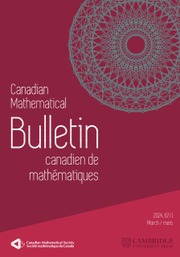Article contents
The Wedge-of-the-edge Theorem: Edge-of-the-wedge Type Phenomenon Within the Common Real Boundary
Published online by Cambridge University Press: 07 January 2019
Abstract
The edge-of-the-wedge theorem in several complex variables gives the analytic continuation of functions defined on the poly upper half plane and the poly lower half plane, the set of points in  $\mathbb{C}^{n}$ with all coordinates in the upper and lower half planes respectively, through a set in real space,
$\mathbb{C}^{n}$ with all coordinates in the upper and lower half planes respectively, through a set in real space,  $\mathbb{R}^{n}$. The geometry of the set in the real space can force the function to analytically continue within the boundary itself, which is qualified in our wedge-of-the-edge theorem. For example, if a function extends to the union of two cubes in
$\mathbb{R}^{n}$. The geometry of the set in the real space can force the function to analytically continue within the boundary itself, which is qualified in our wedge-of-the-edge theorem. For example, if a function extends to the union of two cubes in  $\mathbb{R}^{n}$ that are positively oriented with some small overlap, the functions must analytically continue to a neighborhood of that overlap of a fixed size not depending of the size of the overlap.
$\mathbb{R}^{n}$ that are positively oriented with some small overlap, the functions must analytically continue to a neighborhood of that overlap of a fixed size not depending of the size of the overlap.
MSC classification
Information
- Type
- Article
- Information
- Copyright
- © Canadian Mathematical Society 2018
Footnotes
Partially supported by National Science Foundation Mathematical Science Postdoctoral Research Fellowship DMS 1606260.
References
- 4
- Cited by

